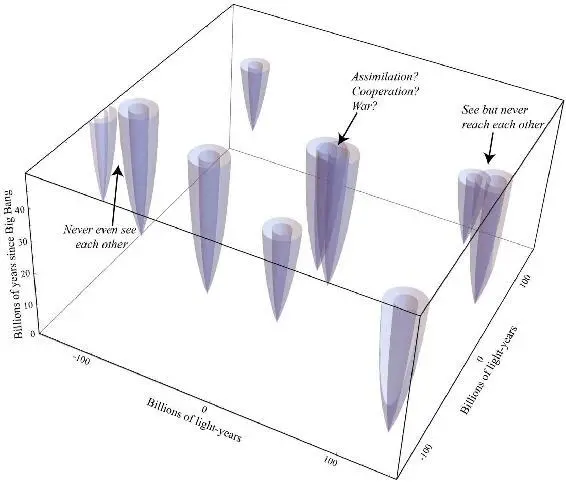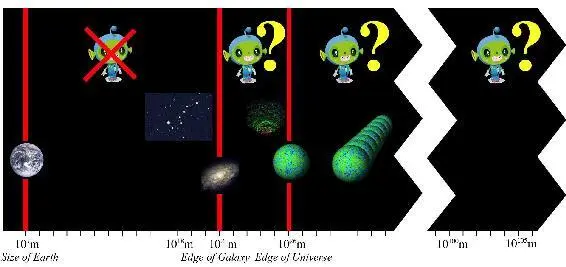
Figure 6.10: If life evolves independently at multiple points in spacetime (places and times) and starts colonizing space, then space will contain a network of expanding cosmic biospheres, each of which resembles the top of the champagne glass from figure 6.7. The bottom of each biosphere represents the place and time when colonization began. The opaque and translucent champagne glasses correspond to colonization at 50% and 100% of the speed of light, respectively, and overlaps show where independent civilizations meet.
Europeans were able to conquer Africa and the Americas because they had superior technology. In contrast, it’s plausible that long before two superintelligent civilizations encounter one another, their technologies will plateau at the same level, limited merely by the laws of physics. This makes it seem unlikely that one superintelligence could easily conquer the other even if it wanted to. Moreover, if their goals have evolved to be relatively aligned, then they may have little reason to desire conquest or war. For example, if they’re both trying to prove as many beautiful theorems as possible and invent as clever algorithms as possible, they can simply share their findings and both be better off. After all, information is very different from the resources that humans usually fight over, in that you can simultaneously give it away and keep it.
Some expanding civilizations might have goals that are essentially immutable, such as those of a fundamentalist cult or a spreading virus. However, it’s also plausible that some advanced civilizations are more like open-minded humans—willing to adjust their goals when presented with sufficiently compelling arguments. If two of them meet, there will be a clash not of weapons but of ideas, where the most persuasive one prevails and has its goals spread at the speed of light through the region controlled by the other civilization. Assimilating your neighbors is a faster expansion strategy than settlement, since your sphere of influence can spread at the speed with which ideas move (the speed of light using telecommunication), whereas physical settlement inevitably progresses slower than the speed of light. This assimilation will not be forced such as that infamously employed by the Borg in Star Trek, but voluntary based on the persuasive superiority of ideas, leaving the assimilated better off.
We’ve seen that the future cosmos can contain rapidly expanding bubbles of two kinds: expanding civilizations and those death bubbles that expand at light speed and make space uninhabitable by destroying all our elementary particles. An ambitious civilization can thus encounter three kinds of regions: uninhabited ones, life bubbles and death bubbles. If it fears uncooperative rival civilizations, it has a strong incentive to launch a rapid “land grab” and settle the uninhabited regions before the rivals do. However, it has the same expansionist incentive even if there are no other civilizations, simply to acquire resources before dark energy makes them unreachable. We just saw how bumping into another expanding civilization can be either better or worse than bumping into uninhabited space, depending on how cooperative and open-minded this neighbor is. However, it’s better to bump into any expansionist civilization (even one trying to convert your civilization into paper clips) than a death bubble, which will continue expanding at the speed of light regardless of whether you try to fight it or reason with it. Our only protection against death bubbles is dark energy, which prevents distant ones from ever reaching us. So if death bubbles are indeed common, then dark energy is actually not our enemy but our friend.
Are We Alone?
Many people take for granted that there’s advanced life throughout much of our Universe, so that human extinction wouldn’t matter much from a cosmic perspective. After all, why should we worry about wiping ourselves out if some inspiring Star Trek –like civilization would soon swoop in and re-seed our Solar System with life, perhaps even using their advanced technology to reconstruct and resuscitate us? I view this Star Trek assumption as dangerous, because it can lull us into a false sense of security and make our civilization apathetic and reckless. Indeed, I think that this assumption that we’re not alone in our Universe is not only dangerous but also probably false.
This is a minority view, *9and I may well be wrong, but it’s at the very least a possibility that we can’t currently dismiss, which gives us a moral imperative to play it safe and not drive our civilization extinct.
When I give lectures about cosmology, I often ask the audience to raise their hands if they think there’s intelligent life elsewhere in our Universe (the region of space from which light has reached us so far during the 13.8 billion years since our Big Bang). Infallibly, almost everyone does, from kindergartners to college students. When I ask why, the basic answer I tend to get is that our Universe is so huge that there’s got to be life somewhere, at least statistically speaking. Let’s take a closer look at this argument and pinpoint its weakness.
It all comes down to one number: the typical distance between a civilization in figure 6.10 and its nearest neighbor. If this distance is much larger than 20 billion light-years, we should expect to be alone in our Universe (the part of space from which light has reached us during the 13.8 billion years since our Big Bang), and to never make contact with aliens. So what should we expect for this distance? We’re quite clueless. This means that the distance to our neighbor is in the ballpark of 1000 … 000 meters, where the total number of zeroes could reasonably be 21, 22, 23,…, 100, 101, 102 or more — but probably not much smaller than 21, since we haven’t yet seen compelling evidence of aliens (see figure 6.11). For our nearest neighbor civilization to be within our Universe, whose radius is about 10 26meters, the number of zeroes can’t exceed 26, and the probability of the number of zeroes falling in the narrow range between 22 and 26 is rather small. This is why I think we’re alone in our Universe.

Figure 6.11: Are we alone? The huge uncertainties about how life and intelligence evolved suggest that our nearest neighbor civilization in space could reasonably be anywhere along the horizontal axis above, making it unlikely that it’s in the narrow range between the edge of our Galaxy (about 10 21meters away) and the edge of our Universe (about 10 26meters away). If it were much closer than this range, there should be so many other advanced civilizations in our Galaxy that we’d probably have noticed, which suggests that we’re in fact alone in our Universe.
I give a detailed justification of this argument in my book Our Mathematical Universe, so I won’t rehash it here, but the basic reason for why we’re clueless about this neighbor distance is that we’re in turn clueless about the probability of intelligent life arising in a given place. As the American astronomer Frank Drake pointed out, this probability can be calculated by multiplying together the probability of there being a habitable environment there (say an appropriate planet), the probability that life will form there and the probability that this life will evolve to become intelligent. When I was a grad student, we had no clue about any of these three probabilities. After the past two decades’ dramatic discoveries of planets orbiting other stars, it now seems likely that habitable planets are abundant, with billions in our own Galaxy alone. The probability of evolving life and then intelligence, however, remains extremely uncertain: some experts think that one or both are rather inevitable and occur on most habitable planets, while others think that one or both are extremely rare because of one or more evolutionary bottlenecks that require a wild stroke of luck to pass through. Some proposed bottlenecks involve chicken-and-egg problems at the earliest stages of self-reproducing life: for example, for a modern cell to build a ribosome, the highly complex molecular machine that reads our genetic code and builds our proteins, it needs another ribosome, and it’s not obvious that the very first ribosome could evolve gradually from something simpler.10 Other proposed bottlenecks involve the development of higher intelligence. For example, although dinosaurs ruled Earth for over 100 million years, a thousand times longer than we modern humans have been around, evolution didn’t seem to inevitably push them toward higher intelligence and inventing telescopes or computers.
Читать дальше














